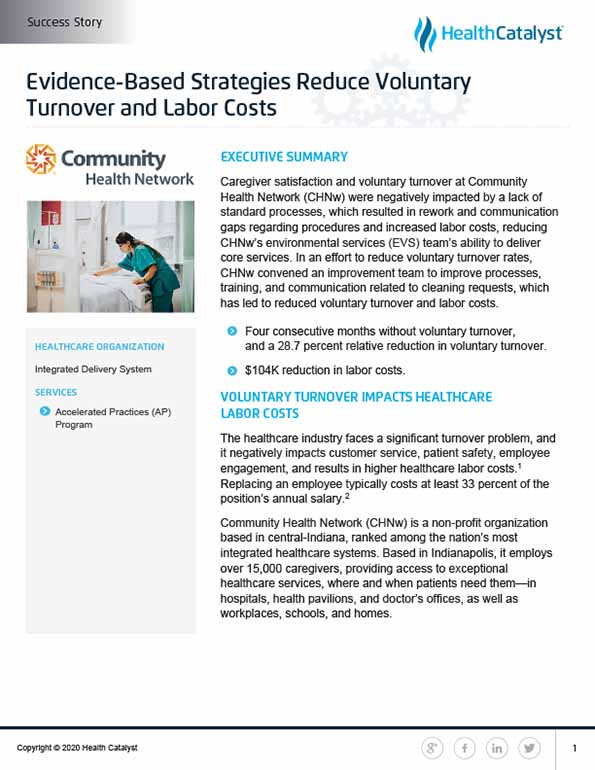Caregiver satisfaction and voluntary turnover at Community Health Network (CHNw) were negatively impacted by a lack of standard processes, which resulted in rework and communication gaps regarding procedures and increased labor costs, reducing CHNw’s environmental services (EVS) team’s ability to deliver core services. In an effort to reduce voluntary turnover rates, CHNw convened an improvement team to improve processes, training, and communication related to cleaning requests, which has led to reduced voluntary turnover and labor costs.
The healthcare industry faces a significant turnover problem, and it negatively impacts customer service, patient safety, employee engagement, and results in higher healthcare labor costs.1 Replacing an employee typically costs at least 33 percent of the position’s annual salary.2
Community Health Network (CHNw) is a non-profit organization based in central-Indiana, ranked among the nation’s most integrated healthcare systems. Based in Indianapolis, it employs over 15,000 caregivers, providing access to exceptional healthcare services, where and when patients need them—in hospitals, health pavilions, and doctor’s offices, as well as workplaces, schools, and homes.
CHNw recognized an opportunity to improve caregiver engagement and decrease voluntary turnover within the EVS department. The EVS team lacked standard processes, resulting in rework, and gaps in communication regarding procedures that contributed to lower team member satisfaction and substantial voluntary turnover. This resulted in increased labor costs and negatively impacted the EVS team’s ability to deliver its core services.
Environmental service partners play a vital role in the experience and quality received by patients, along with impacting safety, compelling CHNw to invest in decreasing voluntary turnover within the EVS department.
CHNw’s senior leadership offered executive support and resources to focus improvement efforts on reducing EVS voluntary turnover. An improvement team was assembled with critical stakeholders, including EVS leadership, an EVS trainer, house supervisors, nurse managers, human resources personnel, a performance excellence consultant, and a data architect.
To enhance the team’s effectiveness, EVS improvement leaders completed the Health Catalyst® Accelerated Practices (AP) Program, an immersive and project-based experiential course that incorporates real-world application of the tools and knowledge required to achieve significantly better outcomes. The improvement team applied their learnings from the AP Program to reduce EVS voluntary turnover.
The improvement team reviewed literature and exit interview data to understand the reasons for employees leaving their jobs. Members of the improvement team performed direct observations of EVS team members while they performed their daily work. Modeling servant leadership, the EVS supervisor sought to understand the existing processes, working with the team to remove barriers that made it difficult for the EVS team to complete their work, and guiding the EVS team to recognize their value as crucial members of the care team.
Using feedback from EVS team members, CHNw concentrated its improvement efforts on systemizing new hire orientation, standardizing and communicating the room cleaning process, improving interdepartmental communication, and training leadership on the processes for direct observation of performance and coaching for improvement.
To ensure consistent messaging on the roles and responsibilities of EVS team members, EVS leadership developed and implemented a standard orientation plan for all new EVS team members. Those members who train new hires receive information about the training plan, and are taught how to best train new hires, preparing both the trainer and new hire for success. Baseline expectations and the standard work for room cleaning upon patient discharge were re-established, with all EVS team members receiving education regarding related expectations and processes.
CHNw implemented a process for using the EMR bed tracking functionality to communicate room cleaning needs. Nursing enters the room clean request in the EMR, improving communication between nursing and EVS, and reducing re-work. EVS team members receive notification electronically when a room is ready for cleaning and assign responsibility to an EVS team member.
Leadership observes team member performance to ensure adherence to the standard process. They are able to review performance data, including the time of cleaning request, time to completion, and the specific team member who completed the room clean. Leaders use the data to identify gaps in the process and provide coaching when indicated.
Multiple department leaders, including EVS, infection prevention, and nursing, have incorporated routine room inspections into their daily work, ensuring EVS team members are able to meet organizational expectations.
CHNw’s data-driven improvement efforts have reduced voluntary turnover and labor costs, while also improving room cleanliness. Results include:
“All the stakeholders participating in the voluntary turnover reduction improvement initiative came together and asked, ‘Are we telling our people what they need to know to get the job done?’ The answer was no, so we implemented and adhered to an accountability process that worked beautifully. Now, we have real-time data and analytics to support the workflow, and managers know what processes to follow to maintain low voluntary turnover and contain labor costs.”
– Tiffany Eddington, PMP, CSM, CSSBB Manager, Performance Excellence
CHNw continues to monitor caregiver satisfaction and voluntary turnover rates, acting on opportunities for improvement as they arise.


